Black pilots had to fight for every step forward
The Tuskegee Airmen were black American pilots who served in the Army Air Corps during the Second World War. However, before earning their wings, these men and women needed to prove themselves to their white countrymen. After all, the racism prevalent at the time meant that black Americans were deemed unsuitable for the demands of modern war. In Tuskegee Airmen: Dogfighting with the Luftwaffe and Jim Crow, the inspiring history of these men is recounted detailing the struggles the men faced at home and abroad. We asked the Dutch author Samuel de Korte some questions by e-mail about his book.
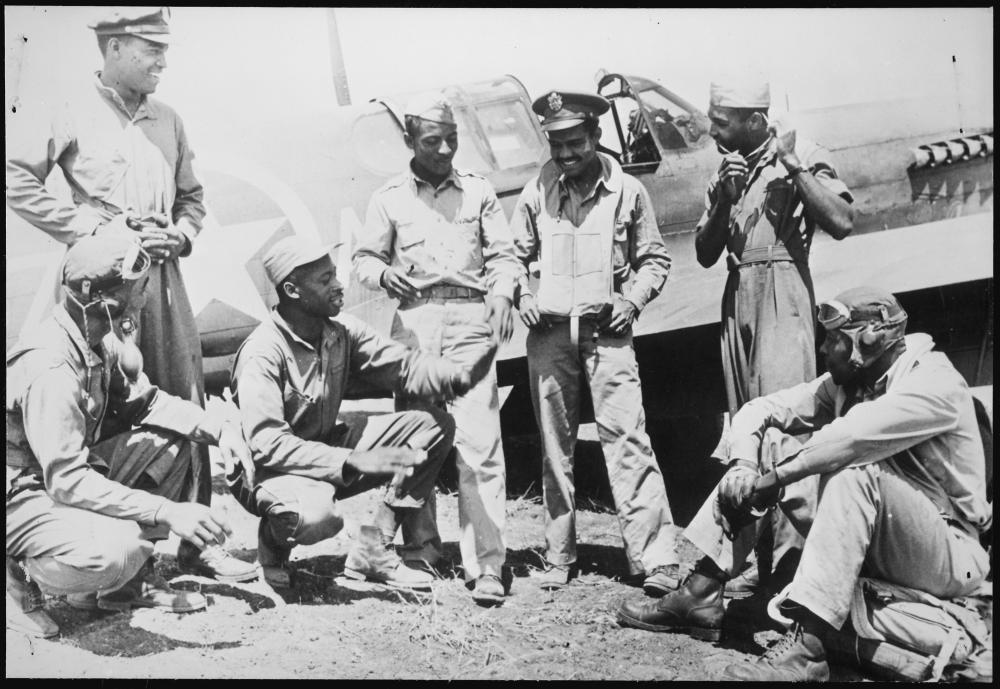 Pilots of the 99th Fighter Squadron, credited with shooting down 8 German planes destroyed in dogfights over the new Allied beachheads south of Rome, on January 27, talk over the day's exploits at a U.S. base in the Mediterranean theater. Source: Courtesy of National Archives and Records Administration
Pilots of the 99th Fighter Squadron, credited with shooting down 8 German planes destroyed in dogfights over the new Allied beachheads south of Rome, on January 27, talk over the day's exploits at a U.S. base in the Mediterranean theater. Source: Courtesy of National Archives and Records Administration
When and why did you decide to write a book about the Tuskegee Airmen?
I want to raise awareness for the diversity of the past. I do this by writing about Black American units during the Second World War. Previously I worked on the 614th Tank Destroyer Battalion, another segregated American army unit. I wanted to continue my research in this area and the Tuskegee Airmen seemed to be a good starting point. However, the experiences of the Tuskegee Airmen are much broader than I initially thought. They served as bomber escorts in the red-tailed P-51s as part of the 332nd Fighter Group, which most people know about, but also in the 477th Bombardment Group, which never entered combat due to the mishandling of their superior officers. Lastly, there were artillery liaison pilots, who served with Black artillery battalions.
You write the Tuskegee Airmen had not one but two enemies to overcome: the German Luftwaffe and Jim Crow. What kind of struggles did the men face at home and abroad in relation to racial segregation?
The racism and abuse that these men faced were staggering by any standard today. The men faced adversity from their enemies as well as their fellow countrymen. In combat, the threat was obvious. Enemy aircraft and enemy pilots used all their equipment and skills to take down the Tuskegee Airmen. However, the enemies at home were a lot more tenacious and not always obvious.
Initially, white people doubted the abilities of Black people. In 1925 a study by the War Department titled ‘Employment of Negro Man Power in War’ claimed that Black Americans were “mentally inferior to the white man”. On the ground, this meant that Blacks were deemed unsuitable for modern war and Black people were deemed incapable of flying an airplane. Moreover, they didn’t want Black people to prove themselves as being equal. The Black pilots really had to fight for every step forward. Even when the fighting in Europe was over, they were denied opportunities that were available to white people and they were denied credit for their actions.
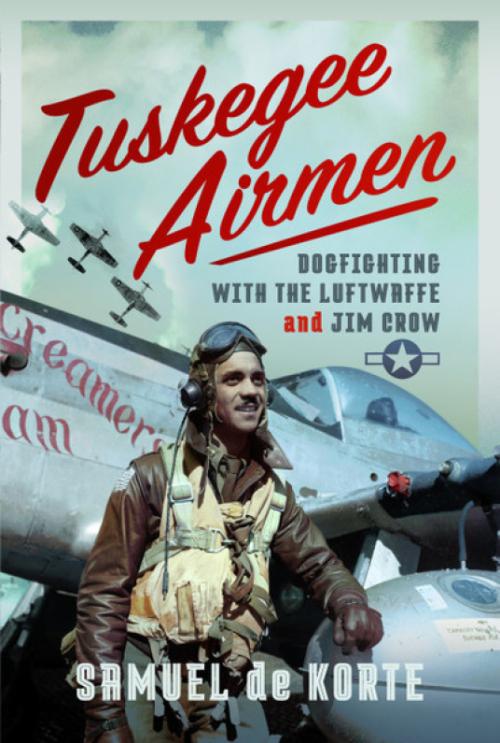 Did you find out what motivated the men to fight in a war that wasn’t theirs, in an army that discriminated against them?
Did you find out what motivated the men to fight in a war that wasn’t theirs, in an army that discriminated against them?
The Second World War accelerated several social changes. In the years leading up to the Second World War, there had been little progress. For example, there were no units to which Black pilots could be assigned and there were no training facilities available. That changed during the conflict. Meanwhile, the Tuskegee Airmen seized the opportunity. For some, it was a chance to fly, which had been impossible in the previous years, while others saw it as a chance to do their patriotic duty. They wanted to prove themselves as equal to white people. They wanted to show white Americans what they could do. Black Americans were not granted the same rights as white Americans and for many of them, this was a step in the process of proving themselves worthy. If they could serve in times of war, they could also be relied on in times of peace.
What sources did you use to write your book? Did you discover something that surprised you or that you didn't know yet?
There are plenty of sources on the Tuskegee Airmen, including memoirs, newspapers and documents of the unit. Each of these sources has its own approach. Personally, one event I knew little about was the Freeman Field Mutiny (April 1945). The 477th Bombardment Group, consisting of the 616th, 617th, 618th and 619th Bombardment Squadron, was a segregated bombardment group. The pilots, as well as all other roles on board the aircraft, such as navigators and gunners, were Black. The 477th Bombardment Group flew in the B-25 Mitchell bomber and the unit suffered from inadequate leadership. Although the unit spent a lot of time in training, the men and resources were squandered due to racism.
Colonel Robert Selway, the commander of the unit, attempted to implement segregation policies which damaged unit morale. He created two officers’ clubs, one for ‘trainees’ and one for ‘instructors’. The white officers were all instructors while the Black officers were all trainees. It violated army policy, which ordered that all officers could use all officers’ clubs on a base.
On 5 and 6 April 1945 a non-violent attempt was made to integrate the officers' clubs, when Black officers tried to enter the white officers’ club. It resulted in 61 arrests and a few days later a proclamation needed to be signed outlining which officers could use which officers’ club. In total 101 officers refused to sign this order and they were arrested for insubordination. The army didn’t know what to do with the situation, since the Black press and the US Congress were also watching the case closely. In the end, all 101 arrested officers were released, except for one, who was fined for pushing a military policeman.
For me, the event is outstanding, because it’s a waste of resources. Time and money were devoted to prevent fellow countrymen from fulfilling their military duty rather than helping them to do it. Furthermore, even though no military trial was developed, the whole affair was still damaging to unit morale. In the end, the 477th Bombardment Group would never serve in combat.
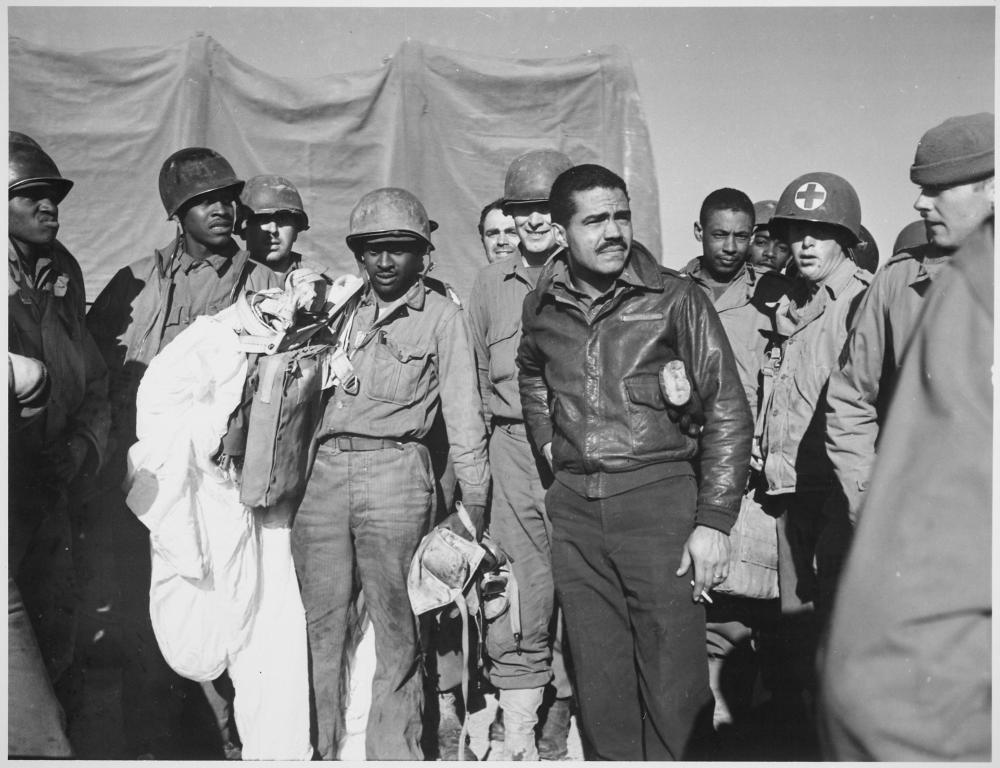 Members of the 99th FIghter Squadron pose for a picture at the Anzion beachhead. Source: Courtesy of National Archives and Records Administration
Members of the 99th FIghter Squadron pose for a picture at the Anzion beachhead. Source: Courtesy of National Archives and Records Administration
How important was the deployment of the Tuskegee Airmen during World War 2 and did they receive sufficient recognition for this at the time, from white airmen and their government?
There are several aspects to this question. The Tuskegee Airmen in Italy, as part of the 332nd Fighter Group, served in combat. White airmen, who were escorted by the 332nd Fighter Group, were grateful for their help. Certain Black pilots were hugged by white bomber crews after escorting a straggling aircraft. Other white pilots dropped by to visit the fighter group and thank the Black pilots in person. Additionally, the 99th Fighter Squadron temporarily served as part of two white fighter groups. One of the white fighter groups developed good relations with the Black pilots and even hosted a farewell party when the 99th Fighter Squadron was transferred to the 332nd Fighter Group. Whereas these pilots have received some credit for their actions, they are a symbol of a much bigger movement. These Black pilots were denied the opportunity to serve, their abilities were questioned, and yet they preserved and overcame all adversity. As such, the actions of these pilots were closely followed by the people at home and covered in the Black press.
However, they are just one aspect of the Tuskegee Airmen. For example, the 477th Bombardment Group never reached the frontline and at that time did not receive any credit for their actions. However, it’s an important event in US history, because it shows the mindset of certain people at that time and how far they were willing to go in treating their fellow countrymen. Their fight against Jim Crow was also important and in recent years their experiences have also been acknowledged. There are even some monuments for this event in the United States.
What happened to the Tuskegee Airmen after World War 2? Was the unit disbanded and how was the return of the airmen to society?
There are two units, the 332nd Fighter Group, which consisted of the 99th, 100th, 301st and 302nd Fighter Squadron, and the 477th Bombardment Group, which consisted of the 616th, 617th and 618th, 619th Bombardment Squadron. After the war in Europe was over, the conflict in the Pacific was still going on. The 477th Bombardment Group was still in training and after the Freeman Field Mutiny, the 99th Fighter Squadron was assigned to it in June 1945. The 477th Bombardment Group became a Composite Group, consisting of both fighters and bombers. However, the needs of the air force changed. The 616th and the 619th Bombardment Squadron were disbanded. In October 1945 the 618th Bombardment Squadron was deactivated. Eventually, the 617th Bombardment Squadron was also disbanded and just the 99th Fighter Squadron remained, which was reorganized as the 332nd Fighter Wing. This unit was eventually also deactivated in 1949 when the United States Air Force integrated. Rather than serve in a single unit, the Black pilots were assigned to other units, thereby integrating the US Air Force.
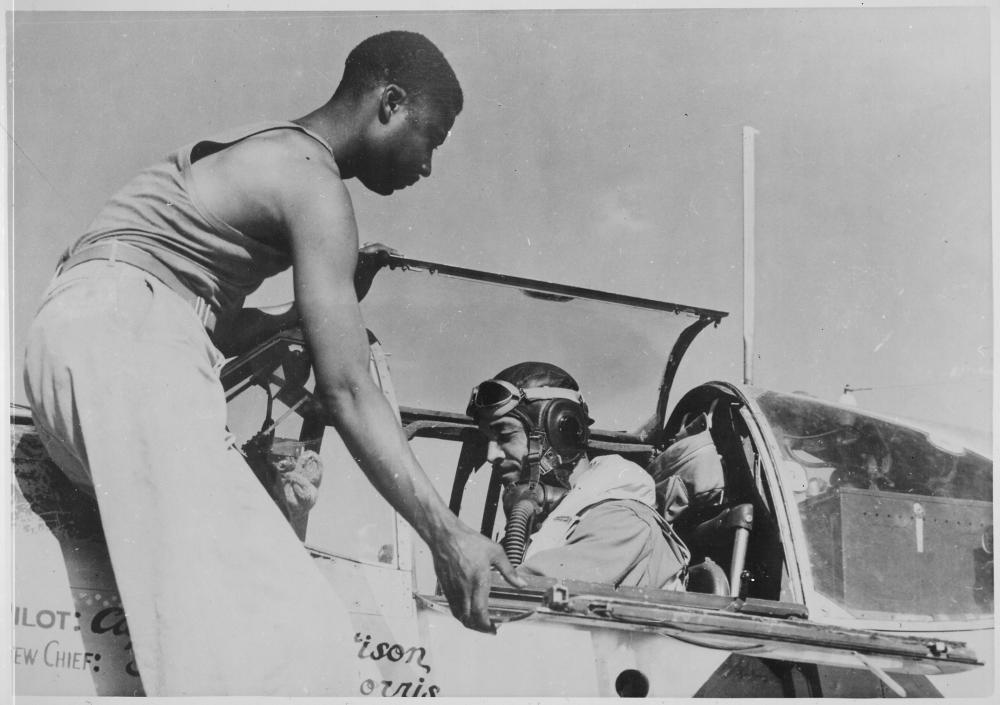 Staff Sergeant Alfred D. Norris closes the canopy of a P-51 Mustang for his pilot, Captain. William T. Mattison. Source: Courtesy of National Archives and Records Administration
Staff Sergeant Alfred D. Norris closes the canopy of a P-51 Mustang for his pilot, Captain. William T. Mattison. Source: Courtesy of National Archives and Records Administration
How is the recognition of the Tuskegee Airmen in the US today?
It’s a lot better than it has been in the past. Monuments are erected for the Tuskegee Airmen. Monuments are even appearing in Italy, such as the one in Ramitelli, where I was present at the unveiling. The same happens in movies or games. This is good because it exposes large groups of people to the history of these brave soldiers as well as raises awareness for their efforts during the war. Also, series, such as the Apple TV+ series Masters of the Air, show the Tuskegee Airmen. Many people have praised the series and it’s good that attention is devoted to the Tuskegee Airmen as well.
What do you hope readers learn or remember from your book?
I hope that it reminds the reader that our past is a lot more diverse and complex than we might sometimes realize. These Black Americans fought, bled, and in some cases died, for their country, yet their service seems to be long forgotten. By looking at their contributions and sacrifices we honor their legacy as well as expand our understanding of the complexities of the past. I hope that my books will contribute to appreciating our shared history.
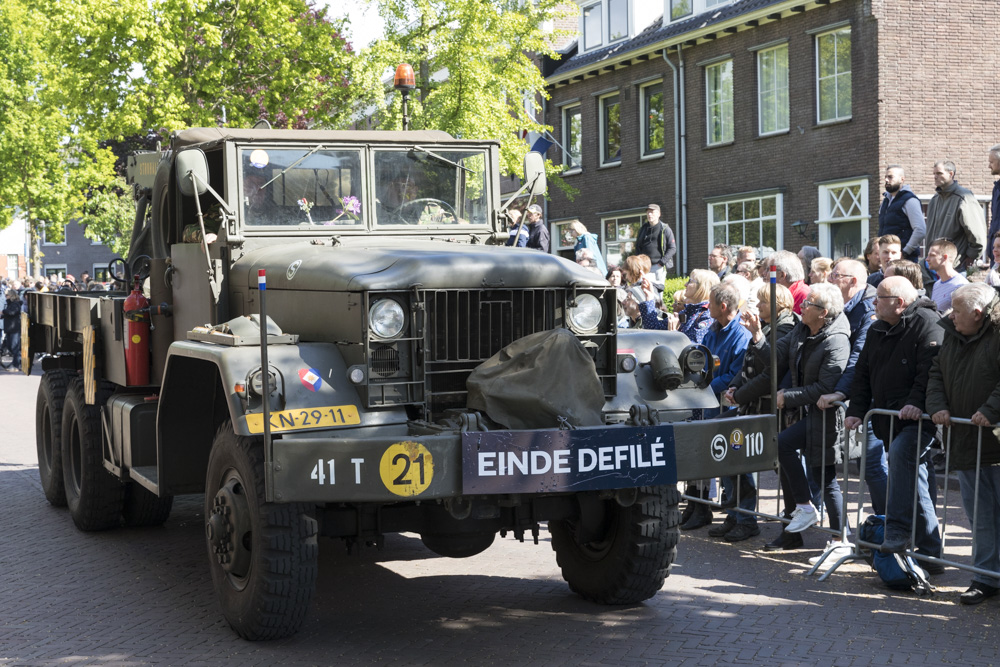
 Pilots of the 99th Fighter Squadron, credited with shooting down 8 German planes destroyed in dogfights over the new Allied beachheads south of Rome, on January 27, talk over the day's exploits at a U.S. base in the Mediterranean theater. Source: Courtesy of National Archives and Records Administration
Pilots of the 99th Fighter Squadron, credited with shooting down 8 German planes destroyed in dogfights over the new Allied beachheads south of Rome, on January 27, talk over the day's exploits at a U.S. base in the Mediterranean theater. Source: Courtesy of National Archives and Records AdministrationWhen and why did you decide to write a book about the Tuskegee Airmen?
I want to raise awareness for the diversity of the past. I do this by writing about Black American units during the Second World War. Previously I worked on the 614th Tank Destroyer Battalion, another segregated American army unit. I wanted to continue my research in this area and the Tuskegee Airmen seemed to be a good starting point. However, the experiences of the Tuskegee Airmen are much broader than I initially thought. They served as bomber escorts in the red-tailed P-51s as part of the 332nd Fighter Group, which most people know about, but also in the 477th Bombardment Group, which never entered combat due to the mishandling of their superior officers. Lastly, there were artillery liaison pilots, who served with Black artillery battalions.
You write the Tuskegee Airmen had not one but two enemies to overcome: the German Luftwaffe and Jim Crow. What kind of struggles did the men face at home and abroad in relation to racial segregation?
The racism and abuse that these men faced were staggering by any standard today. The men faced adversity from their enemies as well as their fellow countrymen. In combat, the threat was obvious. Enemy aircraft and enemy pilots used all their equipment and skills to take down the Tuskegee Airmen. However, the enemies at home were a lot more tenacious and not always obvious.
Initially, white people doubted the abilities of Black people. In 1925 a study by the War Department titled ‘Employment of Negro Man Power in War’ claimed that Black Americans were “mentally inferior to the white man”. On the ground, this meant that Blacks were deemed unsuitable for modern war and Black people were deemed incapable of flying an airplane. Moreover, they didn’t want Black people to prove themselves as being equal. The Black pilots really had to fight for every step forward. Even when the fighting in Europe was over, they were denied opportunities that were available to white people and they were denied credit for their actions.

The Second World War accelerated several social changes. In the years leading up to the Second World War, there had been little progress. For example, there were no units to which Black pilots could be assigned and there were no training facilities available. That changed during the conflict. Meanwhile, the Tuskegee Airmen seized the opportunity. For some, it was a chance to fly, which had been impossible in the previous years, while others saw it as a chance to do their patriotic duty. They wanted to prove themselves as equal to white people. They wanted to show white Americans what they could do. Black Americans were not granted the same rights as white Americans and for many of them, this was a step in the process of proving themselves worthy. If they could serve in times of war, they could also be relied on in times of peace.
What sources did you use to write your book? Did you discover something that surprised you or that you didn't know yet?
There are plenty of sources on the Tuskegee Airmen, including memoirs, newspapers and documents of the unit. Each of these sources has its own approach. Personally, one event I knew little about was the Freeman Field Mutiny (April 1945). The 477th Bombardment Group, consisting of the 616th, 617th, 618th and 619th Bombardment Squadron, was a segregated bombardment group. The pilots, as well as all other roles on board the aircraft, such as navigators and gunners, were Black. The 477th Bombardment Group flew in the B-25 Mitchell bomber and the unit suffered from inadequate leadership. Although the unit spent a lot of time in training, the men and resources were squandered due to racism.
Colonel Robert Selway, the commander of the unit, attempted to implement segregation policies which damaged unit morale. He created two officers’ clubs, one for ‘trainees’ and one for ‘instructors’. The white officers were all instructors while the Black officers were all trainees. It violated army policy, which ordered that all officers could use all officers’ clubs on a base.
On 5 and 6 April 1945 a non-violent attempt was made to integrate the officers' clubs, when Black officers tried to enter the white officers’ club. It resulted in 61 arrests and a few days later a proclamation needed to be signed outlining which officers could use which officers’ club. In total 101 officers refused to sign this order and they were arrested for insubordination. The army didn’t know what to do with the situation, since the Black press and the US Congress were also watching the case closely. In the end, all 101 arrested officers were released, except for one, who was fined for pushing a military policeman.
For me, the event is outstanding, because it’s a waste of resources. Time and money were devoted to prevent fellow countrymen from fulfilling their military duty rather than helping them to do it. Furthermore, even though no military trial was developed, the whole affair was still damaging to unit morale. In the end, the 477th Bombardment Group would never serve in combat.
 Members of the 99th FIghter Squadron pose for a picture at the Anzion beachhead. Source: Courtesy of National Archives and Records Administration
Members of the 99th FIghter Squadron pose for a picture at the Anzion beachhead. Source: Courtesy of National Archives and Records AdministrationHow important was the deployment of the Tuskegee Airmen during World War 2 and did they receive sufficient recognition for this at the time, from white airmen and their government?
There are several aspects to this question. The Tuskegee Airmen in Italy, as part of the 332nd Fighter Group, served in combat. White airmen, who were escorted by the 332nd Fighter Group, were grateful for their help. Certain Black pilots were hugged by white bomber crews after escorting a straggling aircraft. Other white pilots dropped by to visit the fighter group and thank the Black pilots in person. Additionally, the 99th Fighter Squadron temporarily served as part of two white fighter groups. One of the white fighter groups developed good relations with the Black pilots and even hosted a farewell party when the 99th Fighter Squadron was transferred to the 332nd Fighter Group. Whereas these pilots have received some credit for their actions, they are a symbol of a much bigger movement. These Black pilots were denied the opportunity to serve, their abilities were questioned, and yet they preserved and overcame all adversity. As such, the actions of these pilots were closely followed by the people at home and covered in the Black press.
However, they are just one aspect of the Tuskegee Airmen. For example, the 477th Bombardment Group never reached the frontline and at that time did not receive any credit for their actions. However, it’s an important event in US history, because it shows the mindset of certain people at that time and how far they were willing to go in treating their fellow countrymen. Their fight against Jim Crow was also important and in recent years their experiences have also been acknowledged. There are even some monuments for this event in the United States.
What happened to the Tuskegee Airmen after World War 2? Was the unit disbanded and how was the return of the airmen to society?
There are two units, the 332nd Fighter Group, which consisted of the 99th, 100th, 301st and 302nd Fighter Squadron, and the 477th Bombardment Group, which consisted of the 616th, 617th and 618th, 619th Bombardment Squadron. After the war in Europe was over, the conflict in the Pacific was still going on. The 477th Bombardment Group was still in training and after the Freeman Field Mutiny, the 99th Fighter Squadron was assigned to it in June 1945. The 477th Bombardment Group became a Composite Group, consisting of both fighters and bombers. However, the needs of the air force changed. The 616th and the 619th Bombardment Squadron were disbanded. In October 1945 the 618th Bombardment Squadron was deactivated. Eventually, the 617th Bombardment Squadron was also disbanded and just the 99th Fighter Squadron remained, which was reorganized as the 332nd Fighter Wing. This unit was eventually also deactivated in 1949 when the United States Air Force integrated. Rather than serve in a single unit, the Black pilots were assigned to other units, thereby integrating the US Air Force.
 Staff Sergeant Alfred D. Norris closes the canopy of a P-51 Mustang for his pilot, Captain. William T. Mattison. Source: Courtesy of National Archives and Records Administration
Staff Sergeant Alfred D. Norris closes the canopy of a P-51 Mustang for his pilot, Captain. William T. Mattison. Source: Courtesy of National Archives and Records AdministrationHow is the recognition of the Tuskegee Airmen in the US today?
It’s a lot better than it has been in the past. Monuments are erected for the Tuskegee Airmen. Monuments are even appearing in Italy, such as the one in Ramitelli, where I was present at the unveiling. The same happens in movies or games. This is good because it exposes large groups of people to the history of these brave soldiers as well as raises awareness for their efforts during the war. Also, series, such as the Apple TV+ series Masters of the Air, show the Tuskegee Airmen. Many people have praised the series and it’s good that attention is devoted to the Tuskegee Airmen as well.
What do you hope readers learn or remember from your book?
I hope that it reminds the reader that our past is a lot more diverse and complex than we might sometimes realize. These Black Americans fought, bled, and in some cases died, for their country, yet their service seems to be long forgotten. By looking at their contributions and sacrifices we honor their legacy as well as expand our understanding of the complexities of the past. I hope that my books will contribute to appreciating our shared history.

- Tuskegee Airmen
- Dogfighting with the Luftwaffe and Jim Crow
- ISBN: 9781399043816
- More information about this book

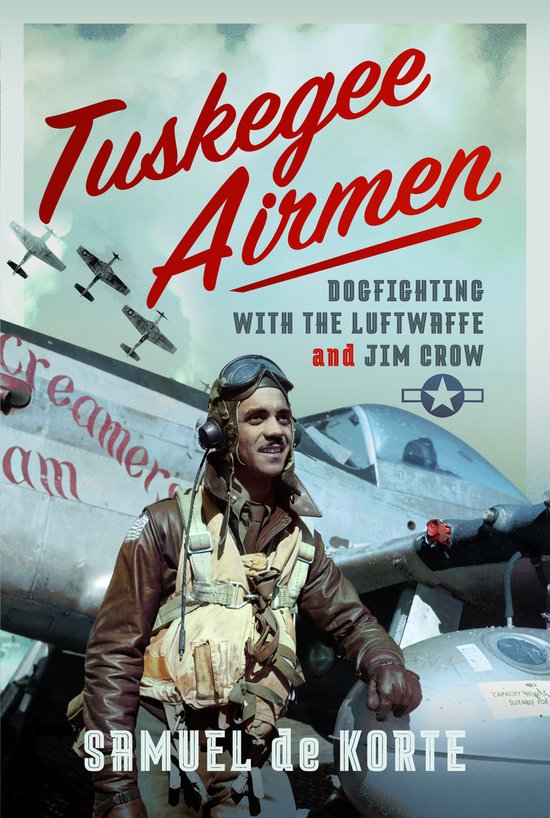
Used source(s)
- Source: TracesOfWar.com / Samuel de Korte
- Published on: 28-03-2024 10:35:00
Related news
- 23-06: Keeping the memory of the trails to freedom alive
- 12-04: Understanding the German side of the fighting in Normandy
- 11-'24: Postal artifacts provide a vibrant testament to the experiences of the Dutch people during WWII
- 10-'24: DigitalBattlefieldTours unlocks military tactics to a wide audience
- 08-'24: Researching his father’s WWII history became a passion for Steve Snyder
Latest news
- 03-10: Photo report other Airborne commemorations and events 2025
- 01-10: Photo report commemoration Wiltshire memorial
- 30-09: Photo report other Airborne commemorations and events 2025
- 26-09: Photo report Ounveiling Plaque 'Gunners within 1st Airborne Division'
- 25-09: Photo report unveiling Plaque 'Gunners within 1st Airborne Division'
- 24-09: Photo report Airborne commemoration Driel
- 23-09: Photo report Airborne Landing and Commemoration
- 22-09: Photo report Airborne Memorial Service Oosterbeek
- 23-06: Keeping the memory of the trails to freedom alive
- 12-04: Understanding the German side of the fighting in Normandy


